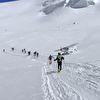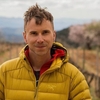Take the long way home new route on Baffin Island, Canada

 1 / 3
1 / 3 Klaus Fengler
Klaus Fengler
The two German climbers Stefan Glowacz and Robert Jasper, accompanied by the photografer Klaus Fengler and the cameramen Holger Heuber and Mariusz Hoffman has made the first ascent of "Take the long way home" (700m, 21 pitches, A4 10-) on a remote granite wall on Baffin Island, Canada.
The team left Pond Inlet and civilisation at the end of April and ventured deep into uncharted territory in search of their dream wall. With the use of Inuit hunters and their snowmobiles they explored the region and, spoilt for choice, finally settled for an obvious line on what they dubbed the "Bastion" close to Buchan Gulf. Anxious about falling behind schedule they set to work immediately, climbing in constant sub temperatures, despite the occasional sunshine. With a mix of free climbing and aid the team first made its way up the lower section to then climb the "smooth headwall split by a single crack system, a perfect line."
The team fixed ropes to help progress and filming and spent a total of 12 days on the wall and 3 nights in portaledges. Although all extremely experienced climbers, Glowacz's early blog entry gives an idea as to the magnitude of the ascent: "none of us have ever climbed in such an exposed setting before. We look out onto icebergs and the open sea, which stretches all the way to Greenland. We need to get used to the rock. Flakes which seem to be safe break without warring. The great range of temperature makes judging the rock quality a difficult task. We have to be extremely careful. An accident here would have serious consequences."
The team summited on 11 May but as usual, reaching the top was only half the story; the return to civilisation took a further 15 days and was carried out on foot and by skis or, with favourable wind conditions, towed by kites. On 02 June they finally reached the safety of Clyde River after having navigated through 350 km of open terrain.
Glowacz is no newcomer to big walls in the artic region: in August 2000 he made the first ascent of "Odyssey 2000" on Baffin Island's Polar Bear Spire together with Kurt Albert, Holger Hember and the photographer Gerd Heidorn. In 2005 Glowacz and Robert Jasper teamed up and the two finally sent their three year project, summiting "Vom Winde verweht" on the North Pillar of Murallón, Patagonia. We checked in with Robert to find out more about their latest climb.
Interview with Robert Jasper - Take the long way home
Take the long way home was your first experience on Canada's Baffin Island, but last year you ventured even further north to Spitzbergen, a mere 1500km from the North Pole. What do you remember about that expedition?
In Spitzbergen the cold was a constant. In our tent in Base Camp the temperature was -29°C, on the wall it dropped to circa -35°C. Unlike most places where one can rely on a good base camp, life here was quite tough. I was there with Slovenian friends and my Swiss climbing partner Markus Stofer and we climbed alpine style in two man teams. We climbed remote walls up to 900m high and up to M7+. It was so cold that we soloed most of the routes just to keep moving, we only roped up for the hardest pitches.
Did Spitzbergen prepare you in any way for Baffin Island?
The testing cold on Spitzbergen prepared me a great deal for Baffin. But for me the most important factor is the mental approach - if you know you can endure such intense cold, then you hold the key to success. You mustn't be afraid of the cold, you have to accept it and go with Nature; learn to love her and it works surprisingly well. If you manage this then it's a fantastic feeling. Spitzbergen also obviously helped me improve my gear and my experience there helped the whole team on Baffin.
What was the hardest aspect of the expedition? The actual climb or the long way home?
The wall was very difficult. We're climbers so we're used to this, we reckoned this would be the case and we trained beforehand. But nevertheless we came across some dodgy moments: on the A4 pitch for example two Cliffs ripped out, but miraculously a third Cliff held the fall - we were extremely lucky. The return with our 100kg Pulkas across 350km of untracked icepack and the frozen sea needed getting used to. We were very exposed to the storms and the endless horizon seems very depressing, especially since you make extremely slow progress indeed. It proved to be nerve wracking and it was definitely a new experience.
How do you interpret “by fair means”?
I don't really like using this expression, everyone knows it really depends on how you define it. “Completely fair means” would mean swimming from here and climbing naked without gear, but this is unrealistic, isn't it? In my expeditions I try to reduce the technical impact as much as possible. Less technical help means more personal commitment and sacrifices. Which means that in the end I experience more, and this is what it's all about. My ideal expedition is alpine style in small teams, as little fixed ropes and bolts as possible, and ideally as much free climbing on rock and ice as possible, making it really adventurous. Our Baffin expedition was followed by a very interesting but also complicated film project, which meant I personally had to make numerous compromises. We had to fix a great deal of ropes for the film crew as it would have been impossible otherwise to film something professionally. We had a very limited number of days on the wall and we climbed for 12 days even through bad weather since we still had to make our long return across the ice. Our five days in a row with portaledges was a great experience and we were extremely lucky with the weather. I really hope finished film turns out to be something authentic. What's important for me is that the climb and the experiences in the wild are renderered true to life, natural. It was a great adventure. If we manage to transmit a fascination for nature, a dream for adventure, survival and belief in a personal summit, then it will have been worth the effort.
Can things be done even fairer?
If we're completely honest then I think everything can be done even fairer. But one also has to understand what the goal of each individual expedition is. Pure alpine style of Russian expedition style - everyone is free to do what they believe in. In the end though one has to be clear about what one has accomplished and in what style. This is the most honest approach of all.
| Links Planetmountain | |
| News Robert Jasper | |
| News Stefan Glowacz | |
| Polar Big Wall Expedition 2000 | |
| Spitzbergen 2007 | |
| Links Expo.Planetmountain | |
| Expo Mountain Hardwear | |
| Links www | |
| www.robert-jasper.de | |
| www.baffinexpedition.com | |



 Copia link
Copia link
























